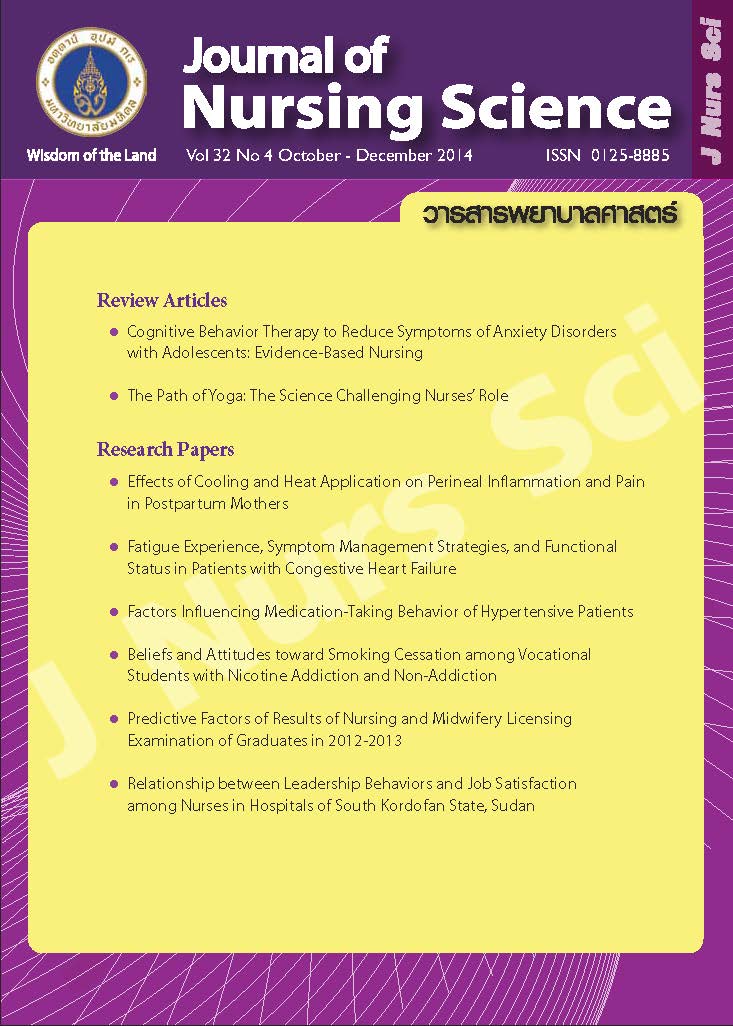Predictive Factors of Results of Nursing and Midwifery Licensing Examination of Graduates in 2012-2013
Main Article Content
Abstract
Purpose: To investigate factors affecting the results of licensing examination of baccalaureates from faculty of nursing, a government university in 2012-2013.
Design: Retrospective-descriptive study.
Methods: Subjects were 164 and 281 baccalaureate graduates in academic years of 2012 and 2013. They were recruited according to these inclusion criteria: a student was not repeated in any class and had complete data of all variables in this study. All data were collected from registration and evaluation section and academic service of the faculty of nursing. Data were analyzed by descriptive statistics and Stepwise Multiple Regression Analysis.
Main findings: The results revealed that the only factor that could predict the results of Nursing and Midwifery Licensing Examination in 2012 was the summative score of all subjects in comprehensive examination (β = .45, p < .01). The only factor that could predict the results of Nursing and Midwifery Licensing Examination in 2013 was the number of subjects that they had passed in comprehensive examination (β = .19, p < .01).
Conclusion and recommendations: The results from the two samples were different. However, they were related to comprehensive examination. The summative score and the number of subjects that they had passed in the comprehensive examination could partly predict the results of the Nursing and Midwifery Licensing Examination. Therefore, the standard of comprehensive examination management should be continued to enhance the readiness of the graduates to take Nursing and Midwifery Licensing Examination in the future.
Keywords: predictive factors, nursing and midwifery licensing examination, comprehensive examination in nursing
ปัจจัยทำนายผลการสอบความรู้เพื่อขอรับใบอนุญาตประกอบวิชาชีพการพยาบาลและการผดุงครรภ์ของบัณฑิตประจำปี พ.ศ. 2555-2556
บทคัดย่อ
วัตถุประสงค์: ศึกษาปัจจัยทำนายผลการสอบความรู้เพื่อขอรับใบอนุญาตประกอบวิชาชีพการพยาบาลและการผดุงครรภ์ของบัณฑิตพยาบาลศาสตร์ มหาวิทยาลัยของรัฐแห่งหนึ่งในปีพ.ศ. 2555 และ พ.ศ. 2556
รูปแบบการวิจัย: การศึกษาย้อนหลังเชิงบรรยาย (Retrospective-descriptive study)
วิธีดำเนินการวิจัย: กลุ่มตัวอย่างในการศึกษาครั้งนี้เป็นบัณฑิตพยาบาลศาสตร์ มหาวิทยาลัยของรัฐแห่งหนึ่งที่สำเร็จการศึกษาในปีพ.ศ. 2555 และ พ.ศ. 2556 คัดเลือกกลุ่มตัวอย่างตามเกณฑ์ คือ เป็นนักศึกษาที่ไม่ตกซ้ำชั้น และมีข้อมูลของตัวแปรที่ใช้ในการศึกษาครบถ้วน ได้กลุ่มตัวอย่างซึ่งเป็นบัณฑิตที่สำเร็จการศึกษาในปีพ.ศ. 2555 จำนวน 164 คน และบัณฑิตที่สำเร็จการศึกษาในปี พ.ศ. 2556 จำนวน 281 คน เครื่องมือที่ใช้ในเก็บรวบรวมข้อมูล คือ แบบบันทึกข้อมูลซึ่งมีการบันทึกมาจากหน่วยทะเบียนและประเมินผลการศึกษา และหน่วยจัดการการศึกษาของสถาบันการศึกษาพยาบาลแห่งหนึ่ง วิเคราะห์ถดถอยพหุแบบขั้นตอน
ผลการวิจัย: ปัจจัยเดียวที่สามารถทำนายผลการสอบความรู้เพื่อขอรับใบประกอบวิชาชีพการพยาบาลและการผดุงครรภ์ ในปี พ.ศ. 2555 ได้อย่างมีนัยสำคัญทางสถิติ คือ คะแนนรวมทุกหมวดวิชาของการสอบรวบยอดสาขาพยาบาลศาสตร์ (β = .45, p < .01) และปัจจัยเดียวที่สามารถทำนายผลการสอบในปีพ.ศ. 2556 ได้อย่างมีนัยสำคัญทางสถิติ คือ จำนวนหมวดวิชาที่สอบผ่านในการสอบรวบยอดสาขาพยาบาลศาสตร์ (β = .19 , p < .01)
สรุปและเสนอแนะ: แม้ว่าปัจจัยทำนายผลการสอบความรู้เพื่อขอรับใบอนุญาตการพยาบาลและการผดุงครรภ์ของกลุ่มตัวอย่างในปีพ.ศ. 2555 และ พ.ศ. 2556 จะแตกต่างกัน แต่เป็นตัวแปรที่เกี่ยวข้องกับการสอบรวบยอดสาขาพยาบาลศาสตร์ คือ คะแนนรวมทุกหมวดวิชา และจำนวนหมวดวิชาที่สอบผ่าน ดังนั้นสถาบันการศึกษาพยาบาลจึงควรให้ความสำคัญกับการสอบรวบยอดสาขาพยาบาลศาสตร์ และรักษามาตรฐานของการจัดการสอบ เพื่อเป็นการเตรียมความพร้อมให้แก่บัณฑิตในการสอบความรู้เพื่อขอรับใบอนุญาตประกอบวิชาชีพการพยาบาลและการผดุงครรภ์ต่อไป
คำสำคัญ: ปัจจัยทำนาย, การสอบความรู้เพื่อขอรับใบอนุญาตประกอบวิชาชีพการพยาบาลและการผดุงครรภ์, การสอบรวบยอดสาขาพยาบาลศาสตร์
Article Details
Copyright Notice: Nursing Science Journal of Thailand has exclusive rights to publish and distribute the manuscript and all contents therein. Without the journal’s permission, the dissemination of the manuscript in another journal or online, and the reproduction of the manuscript for non-educational purpose are prohibited.

Disclaimer: The opinion expressed and figures provided in this journal, NSJT, are the sole responsibility of the authors. The editorial board bears no responsibility in this regard.


